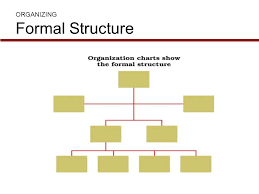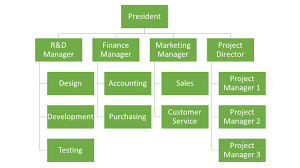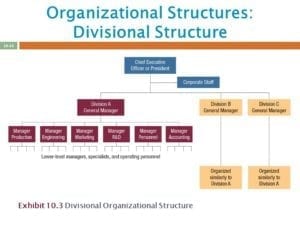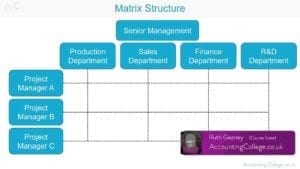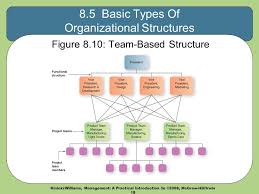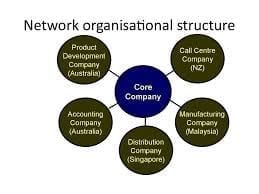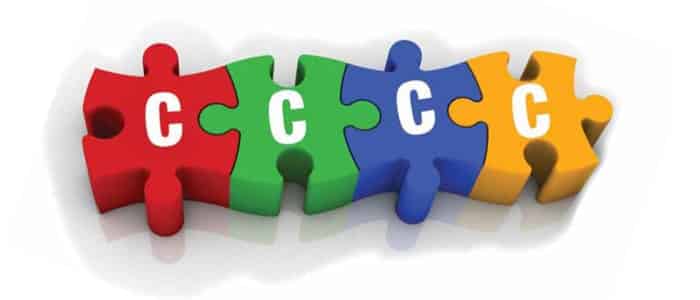There are several different types of organizational structures including formal organizational structure, functional structure, divisional structure, matrix structure, team structure and network structure. Organizational structure is the hierarchical structure of an organization. It tells us how the authority passes on in the organization, and how is task allocation done within. Organizations select from these different types of organizational structures, a structure which suits their operations the most and help them keep things simple.
Different types of organizational structures
Formal organizational structure
A formal organizational structure is the one where an official hierarchical relationship is set amongst people working in the organization. Amongst the different types of organizational structures, a formal organization is one of the best structure that is generally taken. Some people work under others who further work under someone else, and the entire organization works under a CEO (chief executive officer).
The figure shows the fundamentals of a formal organizational structure. Operatives work under the supervisors who work under the department heads who work under vice presidents who finally work under the president. The chain of command is too long here. The formal organizational structure includes matrix structure, functional structure, and divisional structure. The exact opposite of formal organizational structure is the informal organizational structure where an official hierarchical model is not present.
Functional structure
An organization pursuing functional structure’s division is on grounds of the functional units, for example, information technology (IT), sales, marketing, manufacturing, finance and so on. Each functional unit has a head and a set of employees working under them to reach their goal. Each unit has a goal which syncs with other units’ goals to match the overall aim of the organization. It is beneficial in a way that people with the same skills, educational background and expertise are together in a group. Their department head is also one of them and everyone can understand each other.
The figure here demonstrates the details of a functional structure. Board of directors are at the top hierarchy and working for them is the CEO (Chief Executive Officer). Then, different departments come under the CEO, namely: Sales & Marketing, Production, Human Resources, Finance, Research & Development and Purchasing. Each department has a set of employees working under them. For example, customer service under sales and marketing, product assembly under human resources and financial accounting under finance.
Divisional structure
An organization pursuing divisional structure divides its employees under several groups on the region basis, product or service. The division is done in such a way that each group is responsible and answerable for the actions under them. For example, PepsiCo has several global divisions including Frito-Lay North America (FLNA), Quaker Foods North America, Latin America and Europe Sub-Saharan Africa (ESSA) and Asia. (“Global Divisions- PepsiCo”, 2018).
The figure here shows the divisional structure on the product basis. Each product, automobiles, medicines, garments, and textiles, have human resources, purchase, production and marketing departments under them. The figure here shows the divisional structure on the regional division basis. Each division here, division 1 and division 2, have marketing, operations and finance departments under them.
Matrix structure
A matrix structure is the combination of two other different types of organizational structures, the projection system, and functional structures. The structure cancels out the extremes of the two system and balances somewhere in between. A matrix structure forms when employees have to work on two or more projects at once, there is no new hiring from outside. This leads to the employees reporting to two managers. One being their primary manager whose authority flows vertically down the hierarchy. The other being the project manager whose authority flows horizontally, sideways. The flow of authority downwards, as well as sideways, is the reason why this structure is known as the ‘matrix’ structure.
The figure shows how a matrix structure works. Vice presidents of finance, manufacturing, and sales are working under the CEO. The staff is then working under these vice presidents. This shows the vertical flow of authority. On the other hand, there are project managers for project A, project B and project C who are working under the CEO. Now, the same staff is working under these project managers that are working under the vice presidents. This two-way flow of authority forms a matrix.
Team structure
A team structure is the where employees’ placement is done in teams to achieve the pre-set goals of the organization. Each team has a set of objectives to work towards. The employees are given compensation for the completion of those objectives. This way, employees’ motivation to work increases because they are working with their friends and the people who are at the level the same as them. A sense of healthy competition enters into the working too as a result of which it leads to better outcomes for the entire organization.
The figure shows how a team structure works. First, there is an executive team. Then, there is a common services team, and below are management team business units 1 and 2. There are more teams too, for more operations.
Network structure
In a network structure, more than one organizations combine to produce a good or provide a service. These organizations might form a partnership, or one might hire others to work for them on different functions. A famous example of a firm following a network structure is H&M, the famous clothing manufacturer. H&M outsources much of its production and processing in different countries including Bangladesh, Pakistan, China, Denmark, France Germany, India, Indonesia, Italy and more.
(Source: http://sustainability.hm.com), as mentioned in my last article about network structures.
The figure on the left demonstrates how a network structure works. There is a core company that delegates work to other companies or initiates the partnership with them to achieve an objective. Here, the core company is in a partnership with or has done delegation of the work to manufacture company, marketing, and promotion company, distributor, product design company, and engineering company. Delegating work to other companies and paying them for that work is outsourcing. Outsourcing has been increasing lately, mainly due to the cost advantages which the firms get by outsourcing the work. Consequently, other companies whom you outsource work are specialists in what they do. As a result of which, so there is an increase in the chance that their quality of work will be better.

